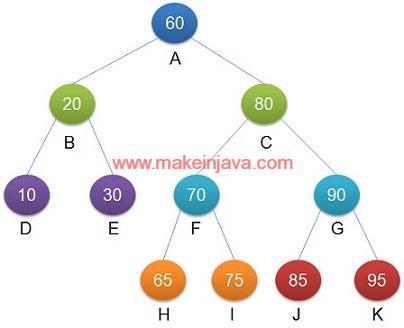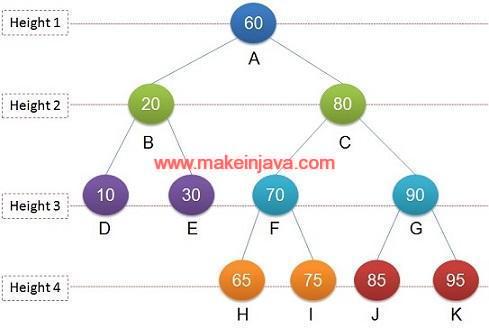- Given a binary tree, find out the height of binary using non recursive algorithm.
- Traverse the binary tree using level order traversal or breadth first search algorithm.
- What is height of Binary tree?
- The longest path from root to deepest leaf node, defines the height of a binary tree.
- Root node of a binary tree is assumed to be at Height 1.
- Calculate the height of binary tree wrt. root node.

Example: find height of a binary tree in java using non recursive algorithm.
- Root Node 60 is at Height 1
- Nodes 20, 80 are at Height 2
- Nodes 10,30,70,90 are at Height 3
- Nodes 65,75,85,95 are at Height 4

Longest path from Root to deepest node is at Height 4.
Algorithm: calculate height of binary tree using breadth first search
- Root is at height 1.
- Push root node to queue.
- Add null to the queue
- null will be level delimiter (marker that we have finished the current level)
- Start iterating through the Queue till it is empty
- Pop node from queue
- Check node is null (if yes, we are next level)
- Increment height by 1 & add level delimiter (null)
- Add next level children (left or/and right)
- At end of iteration, we will get the height of tree
Time complexity of algorithm is O(n).
Program: find height of binary tree in java using non recursive algorithm
1.) HeightOfTree Class:
- HeightOfTree class is responsible for finding the height of a binary tree.
- We will traverse the binary tree using level order traversal or non recursive algorithm.
package org.learn.Question;import java.util.LinkedList;import java.util.Queue;public class HeightOfTree { public static int heightOfTree(Node root) { if (root == null) { System.out.println("Tree is empty"); return -1; } Queue<Node> queue = new LinkedList<Node>(); queue.offer(root); // level delimiter queue.offer(null); int height = 0; while (!queue.isEmpty()) { Node node = queue.poll(); if (null == node) { if (!queue.isEmpty()) { // level delimiter queue.offer(null); } height++; } else { if (node.left != null) { queue.offer(node.left); } if (node.right != null) { queue.offer(node.right); } } } return height; }} |
2.) Node Class:
- Node class is representing the node(s) of a binary tree.
package org.learn.Question;public class Node { public int data; public Node left; public Node right; public Node(int num) { this.data = num; this.left = null; this.right = null; } public Node() { this.left = null; this.right = null; } public static Node createNode(int number) { return new Node(number); }} |
3.) App Class:
- We are constructing the binary in main method.
- We are calling method of HeightOfTree class to find height of binary tree using BFS or level order traversal algorithm.
package org.learn.Client;import org.learn.Question.HeightOfTree;import org.learn.Question.Node;public class App { public static void main(String[] args) { // root level 0 Node A = Node.createNode(60); // Level 1 Node B = Node.createNode(20); Node C = Node.createNode(80); // Level 2 Node D = Node.createNode(10); Node E = Node.createNode(30); Node F = Node.createNode(70); Node G = Node.createNode(90); // Level 3 Node H = Node.createNode(65); Node I = Node.createNode(75); Node J = Node.createNode(85); Node K = Node.createNode(95); // connect Level 0 and 1 A.left = B; A.right = C; // connect level 1 and level 2 B.left = D; B.right = E; C.left = F; C.right = G; // connect level 2 and level 3 F.left = H; F.right = I; G.left = J; G.right = K; int height = HeightOfTree.heightOfTree(null); if (height > 0) { System.out.println("Height of a Binary Tree : " + height); } else { System.out.println("Unable to calculate height of a binary tree"); } }} |
Output: Height of binary tree using breadth first search algorithm
Height of Binary Tree : 4 |
